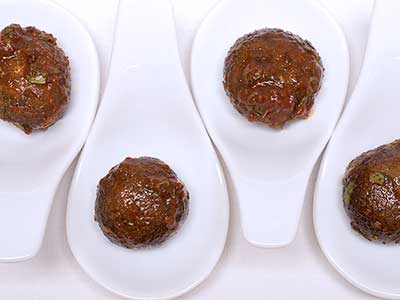February 2, 2015
Amuse-Bouche

champignon mariné
(marinated mushroom)
Mrs. W was a whack-job—a true nut case—my first sixth-grade teacher. She was actually, probably just going through some sort of a breakdown. She had decided to eschew the standard curriculum, and instead, we spent our days doing art projects and going on field trips. On one of those field trips, I visited my first mushroom farm.
To get to the farm, our rickety yellow school bus had to cross a two-lane drawbridge that was built in the 1920s across the southern part of San Francisco Bay. The mushroom farm was a series of battleship-gray, corrugated-metal buildings built near the salt flats that lined that part of the bay. Once inside one of the buildings, the odor was mildly interesting. A row of ceiling mounted, bare, incandescent bulbs illuminated a series of shallow, tray-like shelves on either side of a narrow aisle. There were three or four shelves in each stack with enough vertical space so a worker could reach in and harvest the mushrooms. The trays were filled with sterilized horse manure, which explained the curious aroma. The lights illuminated white mushroom caps of various sizes. Our guide turned off the lights so we could experience the slightly warm, humid, and dark environment that the mushrooms were raised in. Then we got back on the school bus and went home.
Midway through the school year, we came to class one day to be informed by Mr. B, the school’s vice-principal, that Mrs. W was ill and would not be returning to class. Mr. B would be our teacher for the remainder of the year, and there would be no more art projects and field trips. Although we now had to complete the year’s curriculum in half the normal time, class went by fast. Mr. B was a good teacher.
That was early 1960, and the only mushrooms available were what was referred to then as button mushrooms. They only came in white. The most common way to find them was in cans. There were three canned varieties: whole, sliced, and stems and pieces. Brand didn’t seem to make any difference in quality or flavor. They were always cooked and always had a sickly grayish beige color. They had little flavor and that often was reminiscent of the can.
The remainder of the century brought fresh mushrooms to the market. At first just the same white mushrooms I had seen on my farm visit, but eventually almost the same, wide selection available to us today. I also learned about dried mushrooms, especially the dried shiitake mushrooms I used in my Chinese cooking.
I’ve used mushrooms for amuse-bouche dishes twice in the past: champignons tires and champignons mijotés avec de la sauce d’huître. Both dishes used mushroom specimens that were more exotic than the lowly white, button mushroom. Now it’s time for common mushrooms. This recipe for marinated mushrooms is at once both common and unique. Some variation of mushrooms marinated in oil, vinegar, and herbs has been common in this area since the 1960s, and I suspect that in certain ethic groups, long before that. What makes these mushrooms unique is that the marinade solution has a strong paprika base.
This version is my adaptation of a recipe I found at the Serious Eats website. Their recipe was taken from the book Bar Tartine: Techniques and Recipes. Bar Tartine is a local restaurant with a reputation for good food and long lines, but I haven’t eaten there. I have eaten pastries from their bakery, and they were quite good.
16, about 220 g (1⁄2 lb)
white or brown button mushrooms, tightly closed, between 2 and 2-1⁄2 cm (11⁄16 and 1 in) in diameter, stems trimmed flush with the cap
neutral vegetable oil
fine salt
marinade
60 ml (1⁄4 c)
red-wine vinegar
2 large cloves
garlic, grated
1 t
grated onion
1 T
coarsely minced, fresh flat-leaf parsley
1 T
coarsely minced, fresh thyme leaves
2 T
smoked, ground paprika
1 T
dark brown sugar
pinch
fine salt
1. Preheat oven to 180 °C (355 °F).
2. Assemble the marinade. It will be quite paste-like.
3. Toss the mushroom caps with a sprinkle of oil and a little salt. Arrange the mushrooms, stem side down and in a single layer on a baking sheet. Place in your oven, and cook for about 10 minutes.
4. Add the hot mushrooms to the marinade. Transfer the mixture to a storage container, and refrigerate until needed. Stir the mixture daily for the first few days.
5. To serve, give the mushrooms a turn to coat their surfaces. Divide the mushrooms between individual serving spoons, one mushroom per spoon.
Yield: 16 servings.
© 2015 Peter Hertzmann. All rights reserved.
